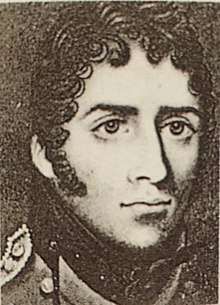Juan Galindo

Juan Galindo (1802–1839) was an Irish explorer and army officer. He fought for Central American independence from Spain and led the charge that took the fortress at Omoa, the last Spanish stronghold in Central America.
Early Years
Galindo was born in Dublin in 1802 as John Galindo.[1] His father, Philemon Galindo was an Englishman of Spanish descent and his mother, Catherine Gough, was Irish.[2] Both parents were actors who met while working at a theater in Bath. They married in Dublin in 1801. His early life is obscure and it is not known why or exactly when he left for the New World.[3] Sources differ on his emigration but sometime before he was twenty he either joined Admiral Thomas Cochrane to fight for Chile's independence or he joined his uncle, a plantation owner in Jamaica.
The first clear record of his early career occurred in in 1827 when he worked as secretary and translator for the British consul in Guatemala. By 1828 he was the superintendent for improvements at the port of Iztapa as well as a major in a Honduras battalion.[4]
Federal Republic of Central America
In 1829 the Liberal forces led by Francisco Morazán invaded Guatemala. Galindo joined the Liberals and Morazán's army quickly brought the revolution to a successful end. Morazán established the Federal Republic of Central America and Galindo enjoyed the patronage of Morazán and Mariano Gálvez, the chief of state in Guatemala. The new federal congress granted Galindo naturalization papers and he changed his name to Juan.[5]
Galindo undertook several military assignments for the new government, including officer of a military garrison at Omoa, commander of the port at Trujillo, and military governor of Petén. In 1834, he received a large land grant in Petén with the stipulations that he pacify the native Lacandon Maya and settle the area in five years with colonists who would be loyal to the Guatemalan government.[2][6] He soon realized that the boundary between Guatemala and Belize was in dispute and the British claimed that Galindo's new land grant belonged to Belize. British mahogany cutters were actively logging the area, depriving Galindo of the land's most valuable asset. When discussions with Frederick Chatfield in Belize failed to resolve the issue, Central America appointed Galindo as envoy to negotiate directly with the British Foreign Office in London.[7]
Galindo left Central America in January, 1835, stopping first in Washington, DC in hopes of enlisting the United States to support his cause against Britain. In return, Galindo offered to provide information regarding possible canal routes through Nicaragua. He met with Secretary of State John Forsyth and President Andrew Jackson in May, 1835 but failed to gain their support. Galindo proceeded to London and arrived there in August. He had a meeting with Foreign Secretary Lord Palmerston soon after his arrival but then talks proceeded in a desultory fashion. By April 1836 Palmerston had determined not to work with Galindo and offered the expedient excuse that since Galindo was born a British subject, he could not represent a foreign government.[8]
Without a clear title to his land grant in Petén, Galindo was unable to attract settlers. Instead, he petitioned Central America for another opportunity and was provided a grant on the Mosquito Coast. While still in London, Galindo recruited his father and other relatives to lead a group of colonists to settle on this remote coast. This enterprise ended in failure; the settlers were ill-equipped, lacked sufficient supplies, and found no way to earn a living once they arrived. By the time Galindo returned to Central America in 1836, the settlement had collapsed and his father had returned to England. He also found that his influence with the Central America government was greatly diminished.
When civil war broke out in Central America, he fought in various battles, but was killed when a Nicaraguan army overran the city of Tegucigalpa.
Maya archaeology
Galindo also explored and wrote descriptive accounts of various ancient Maya ruins, including Palenque and Copán. In 1834, while serving as governor of Petén, he visited Copán and noted the sculpted high-relief stelae there.[9] They are notable as they were first to point out the close resemblance between the contemporary Maya peoples and the carved images of the ancient Maya to be found amongst the ruins. Contrary to ideas that the ancient Maya architecture had been created by peoples such as ancient Egyptians, Polynesians, or even the Lost Tribes of Israel, this suggested that they were built by the contemporary Mayas' ancestors. In 1836, Galindo was elected a member of the American Antiquarian Society.[10]
See also
Notes
References
- Brunhouse, Robert L. (1973). In Search of the Maya: the First Archeologists. University of New Mexico Press. pp. 31–49.
- Drew, David (1999). The Lost Chronicles of the Maya Kings. London, UK: Weidenfeld & Nicolson. ISBN 0-297-81699-3. OCLC 43401096.
- Griffith, William J. (1960). "Juan Galindo, Central American Chauvinist". The Hispanic American Historical Review. 40 (1): 25–52.
Further reading
- Griffith, William J. "Galindo, Juan (1802–1840)." Encyclopedia of Latin American History and Culture, edited by Jay Kinsbruner and Erick D. Langer, 2nd ed., vol. 3, Charles Scribner's Sons, 2008, pp. 353-354.